| |||||||
| Search Forums |
| Advanced Search |
| Go to Page... |
 |
| Search this Thread |  1,054,397 views |
| | #1 |
| Team-BHP Support  Join Date: Apr 2016 Location: Mumbai
Posts: 1,830
Thanked: 21,736 Times
| Hyundai i20 Review Hyundai has finally taken the wraps off the India-spec third-generation i20, and we got to preview the car in Mumbai just before the official launch. It has been launched today at Rs. 6.80 lakh to Rs. 11.18 lakh.  Before the Covid-19 pandemic, the i20 was slated for an international launch at the Geneva Motor Show in March 2020. However, since the motor show got cancelled, the i20 was globally unveiled online and now that the restrictions are easing up worldwide, we have the official launch this festive season in India. You might have seen pictures of the Euro-spec car and yes, it looks very similar to the Indian-spec i20. However, the car for international markets is longer than the Indian car. Reason? The India-spec car’s length has been trimmed down to 3,995 mm to meet the sub-4m category and reap tax benefits. The good news, however, is that the wheelbase has been kept the same as the Euro-spec car at 2,580 mm. Compared to the previous generation Elite i20, this wheelbase is up by 10 mm and Hyundai claims that the interiors are much more spacious than before (more on this later). The car is now wider by 41 mm than the previous generation model at 1,775 mm. The height, however, has been left unchanged at 1,505 mm. The third generation i20 is built on Hyundai-Kia’s K-platform series. Different versions of this platform underpin the current crop of cars from the Korean manufacturer since 2017. The i20 will get a 1.0L turbocharged petrol (we love this motor), a 1.2L naturally-aspirated petrol and a 1.5L turbocharged diesel engine (we love this one too). Hyundai will offer a 7-speed DCT and a clutchless Intelligent Manual Transmission (iMT) with the 118 BHP, 1.0L turbocharged petrol engine. The 87 BHP, 1.2L Petrol will be available with a 5-speed manual transmission or CVT automatic. The 99 BHP, 1.5L diesel engine is offered only with a 6-speed manual transmission. I don't understand the logic of not offering the Diesel AT, especially when Kia is now offering it in the Sonet. There are many Diesel AT fans in India. There are loads of features including LED projector headlamps with LED DRLs, LED taillamps, projector fog lamps, 16-inch diamond-cut alloy wheels, sunroof, wireless charging, 10.24-inch touchscreen with Android Auto and Apple CarPlay connectivity, 7-speaker audio system by BOSE, Bluelink connected car technology, 6 airbags, electronic stability control, hill assist control and more. The new i20 will be available in four variants - Magna, Sportz, Asta and Asta (O). Hyundai is offering a choice of 3 years / 100000 km, 4 years / 50000 km or 5 years / 40000 km as the standard warranty packages. That's unique & very welcome! Extended warranty up to 5 years / 140000 km can be purchased additionally. We strongly recommend this extension. Hyundai is further offering 3 years Road Side Assistance and 3 years Bluelink subscription with the i20. The i20 features a body structure that comprises of 66% Advanced High-Strength Steel. Hyundai claims they have managed to get 13% higher tensile strength from the structure of the new i20:  Hyundai’s recent car designs may have faced some criticism (Creta & Aura), but this one definitely plays it safer. We like the front! There aren’t many overly done bits and while the big grille covers most of the face, it blends in with the design. You'll also notice the lack of round elements or curvy bits. Instead, you have a lot of straight lines in the design:  ‘Parametric Jewel’ pattern is what Hyundai calls this grille design. It extends from the headlights and is finished in gloss black. An air dam sits at the bottom which also gets a gloss black finish:  Bottom of the air dam has a splitter-like design. It’s not something you’ll notice at first glance, but it does look cool:  The bonnet has multiple creases & levels to give out a muscular look:  The car on display was the 118 BHP, 1.0-litre turbo petrol version which gets this red ‘Turbo’ badge on the grille. We're so glad that the i20 has the full 118 BHP and not a detuned version like the Aura / i10. This will be a fast hatchback!  A look at the headlamp cluster. Headlamps feature LED projectors along with LED DRLs. You also get a static cornering light next to the projector. Don’t miss the hexagonal design pattern inside the cluster: 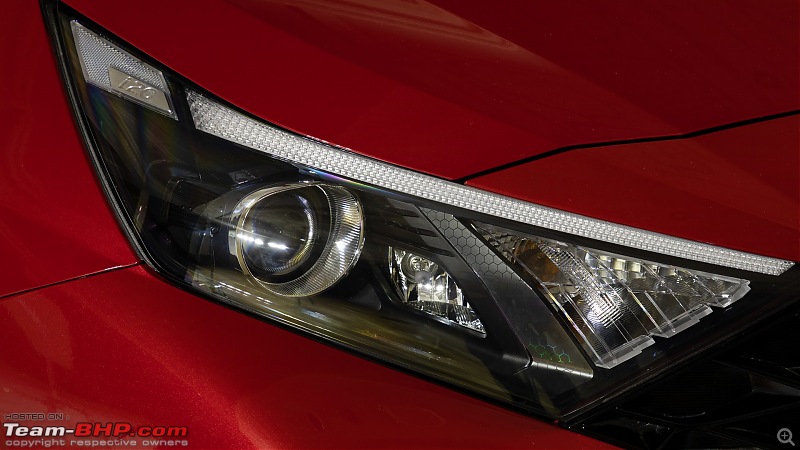 The LED DRLs were bright enough over the artificial lighting in the showcase room. The turn indicators are located on the inside edges of the headlamp cluster: 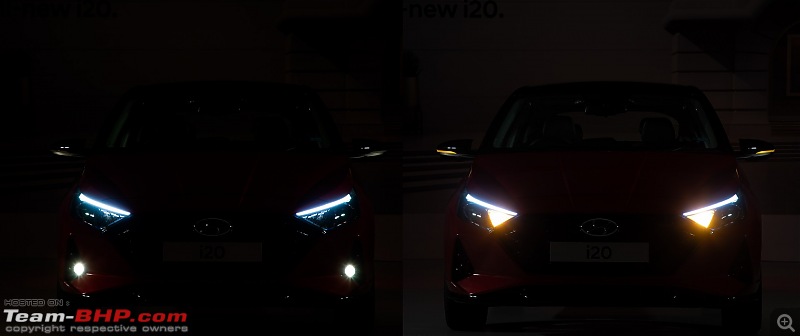 ‘i20’ badge on the outside edge of the headlight: 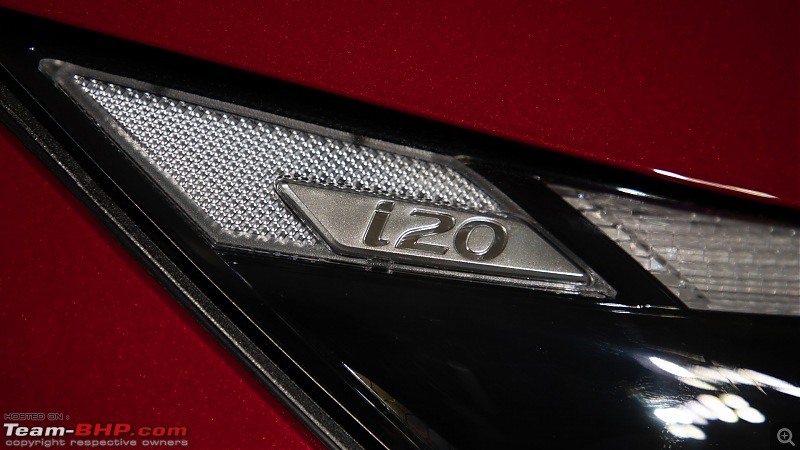 The foglamps are placed in this pizza-slice shaped enclosure, finished in piano black. These are halogen projectors:  3rd-gen car has a longer 2,580 mm wheelbase. The long wheelbase and restricted overall length mean that the front and rear overhangs are minimum. Do note the chrome window sill - we don't like the chrome on the door handles & C-pillar...it's excessive:  16-inch rims have a groovy design! They are shod with 195/55 R16 Ceat SecuraDrive tyres:  ORVMs have integrated blinkers and a black casing: 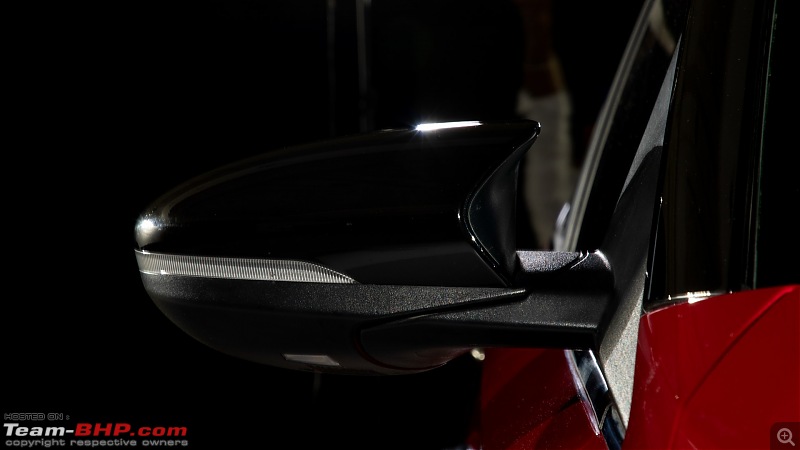 Upon unlocking the car, the horn beeps (meek sounding, single-tone horn) and the puddle lamps come on:  DCT gearbox badging on the right fender:  Sure has a lot of branding & badging! "i20" on the running board; I think it looks quite cool, but GTO doesn't like it:  The first generation i20 had disc brakes at the rear. It was skipped on the Elite i20, and I was hoping this third-generation car would bring them back, but that’s not the case. You get drum brakes at the rear. Hyundai should’ve at least added rear disc brakes on this turbo-petrol variant! Rear wheel well has only partial cladding:  The dual-tone black roof along with the red body colour was recently seen on the Grand i10 Nios turbo petrol variant, and IMO it looks great:  Shark-fin antenna sits at the end of the roof:  The rear looks contemporary with very little to complain about. It looked strange in all the leaked pictures, but after seeing it in person, I have no complaints. Will polarise opinions though. The black colour of the roof extends till the taillamps which looks well integrated from the rear as well as from the side. Notice how the bumper's black bottom reduces the visual bulk of it:  These Z-shaped tail lamps have a split design. The tailgate part houses the turn indicators. There are multiple elements squeezed together neatly on the outside area of the light. The Z-shaped LED element forms the border and next to it is the brake light + reversing light (left to right in this picture). It is quite an intricately designed taillamp. Don't miss the "i20" branding & how the fuel flap has been neatly integrated with the light's design!  A look at the LED element, all lit up:  The use of chrome to connect the taillamps looks tasteless, but well, the mass market loves chrome! Perhaps, an LED element here would’ve felt more upmarket? The chrome Hyundai badge on the piano black applique looks good though (very Tata Altroz like):  Thank God Hyundai decided to drop the ‘Elite’ prefix for the i20. Sounded too cheesy. Not to forget, those names become longer with time (i10 -> Grand i10 -> Grand i10 Nios):  The bumper gets a diffuser-like design at the bottom finished in gloss black. No doubt it looks great, but it is also more likely to show scratches prominently. Check out the reversing camera neatly tucked above the number plate. Wondering if the camera's position is too low?  The end of the C-pillar gets these aero fins similar to the ones seen on the Kona EV (reference image): 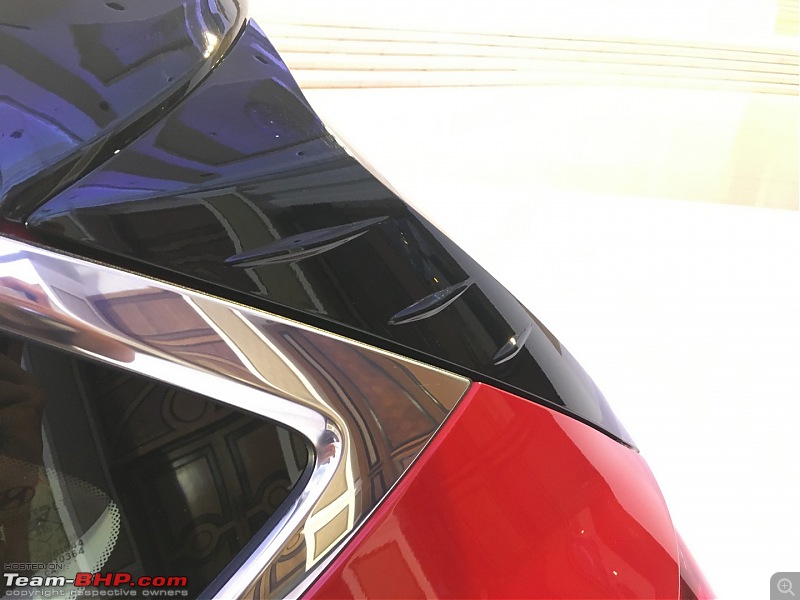 Last edited by Aditya : 5th November 2020 at 13:13. |
| |  (72)
Thanks (72)
Thanks
 |
| The following 72 BHPians Thank Omkar for this useful post: | .anshuman, Abhinav V, ads11, akn1984, akshay81, Arnav Vaghela, ashvek3141, AVIS, AYP, CARDEEP, CEF_Beasts, Chrome6Boy, dailydriver, Dani7766, Dexter_, digitalnirvana, DrANTO, DriverNo.420, espraveen, fluidicjoy, Gaboonviper04, giri1.8, govindremesh, Grand Drive, GTO, Guna, guyfrmblr, hemanth.anand, InControl, KarthikK, kiranknair, klgiridhar, landcruiser123, lovetorque, MSAneesh, N33raj, Nazaar25, Night_Fury, phynix123, Ponbaarathi, Potenza, PraNeel, RaghuVis, Rambo-RS, RavenAvi, RBalaM, RBR, Reinhard, Researcher, Roy.S, RSR, S.MJet, saisailendra, SchumiFan, Shome, Simhi, SuhairZain, swiftnfurious, The Rationalist, theexperthand, The_Outsider!, Utham123, V.Narayan, vaasu, vb-saan, Vid6639, vigneshkumar31, Viju, Vik0728, vredesbyrd, Vysakh, Yeldo |
| |
| | #2 |
| Team-BHP Support  Join Date: Apr 2016 Location: Mumbai
Posts: 1,830
Thanked: 21,736 Times
| This all-black dashboard on the turbo-petrol variant is nice. It’s not overtly exciting though and still has bland-looking bits. You now get these horizontal vent-like slats running across the dashboard which is unique to the i20. In addition to the slats, the steering + large ICE display + digital console catch your eye:  Zooming in on the horizontal slat design of the dashboard. There are no soft-touch plastics here, but the quality is right up there with the best in the segment. Everything is well put together and feels built to last:  This 4-spoke steering wheel is similar to the one we’ve seen on the Venue, except that it is not flat-bottomed. Steering-mounted controls are of good size and have a tactile feel to them:  Fully digital instrument cluster! However, the design layout is hard to comprehend. The digital speedometer is still okay, but the counter-clockwise tachometer - that too digital - are two big NOs IMHO. Too hard to read, especially in a car that’s supposed to be sporty (this particular turbo-petrol variant). Furthermore, the MID placed in the middle is similar to the current crop of Hyundai cars and looks like a mere carryforward. The instrument cluster on the UK variant has a far cleaner, premium design (reference image). Hyundai should’ve either gone the extra mile and gotten that UK one, or just kept it simple with analogue dials:  Tyre pressure monitoring system is a nice addition. Low tyre pressures have caused many high-speed tyre bursts: 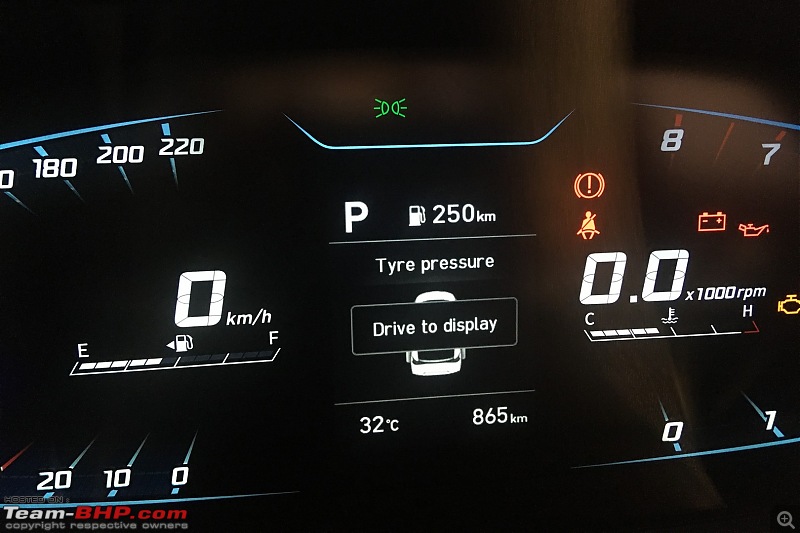 The A/C vents also get red accents on this variant. Check out the neatly integrated start-stop button. The headlamp leveller and rearview monitor buttons have been placed below, along with the traction control button (telling you this car has ESP!):  The horizontal slat theme continues on the door handle panel as well! 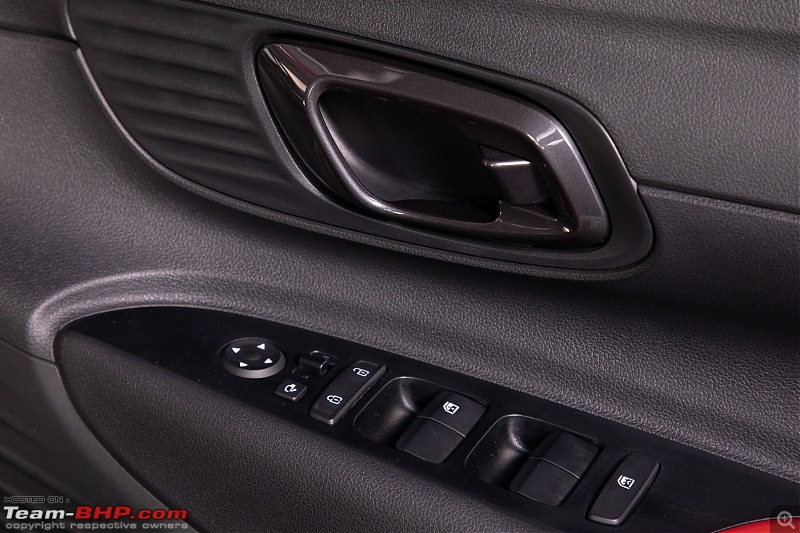 Black & red leather seats are quite comfortable and provide good overall support:  Manual adjustment levers for the driver seat. Notably, the height adjustment has a good range:  Sporty pedals in the turbo-petrol. This floor matting is an accessory which was already in place on the display car. The i20 gets blue-coloured ambient lighting at various places, including the footwell and door pockets:  Sunroofs are fun!  The IRVM houses 3 buttons - SOS will place an emergency call to Hyundai customer care, the button with the tow truck will call Hyundai Roadside Assistance and the third button will launch Blue Link. All that technology, but no auto-dimming?! Come on, Hyundai:  Another big attraction for Indian buyers – this massive 10.24 inch touchscreen. It stands out above the dashboard, alongside the instrument cluster (similar to the Kia Seltos). Has a crisp display with quick guide buttons at the bottom. Another benefit of having a wide screen like this is that you can enjoy a split display:  There are loads of features, including Android Auto and Apple CarPlay. The Bluelink has 50 connected car features including OTA map updates, remote engine start and geo-fencing. You also have voice command features, with the system responding to ‘Hello Bluelink’ followed by your question or command: 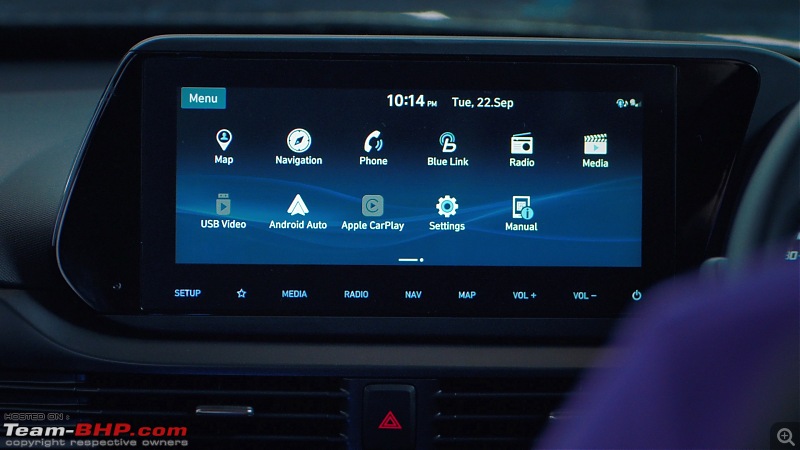 Check out the angle of the A/C controls with respect to the gear lever. The centre fascia is visibly tilted towards the driver which is a big  : : AC controls are minimalistic and sleek to operate. Red-coloured tips here as well: 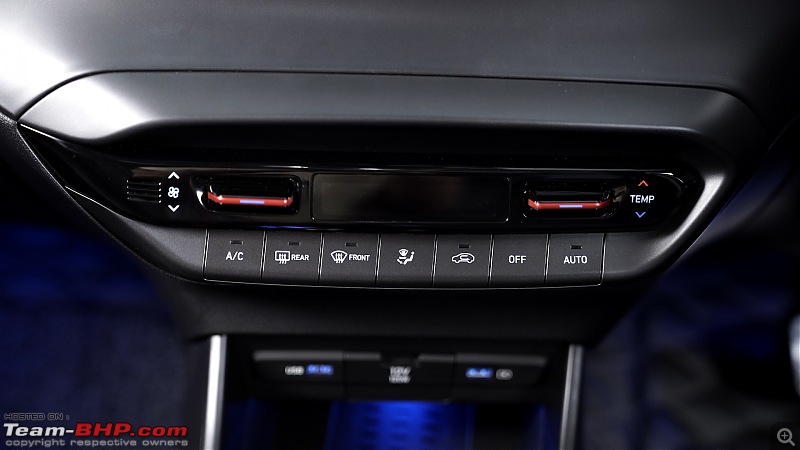 Below, you get 2 backlit USB ports and a 12V charging socket. The space below the slots is occupied by a wireless charging pad which also gets an ambient light: 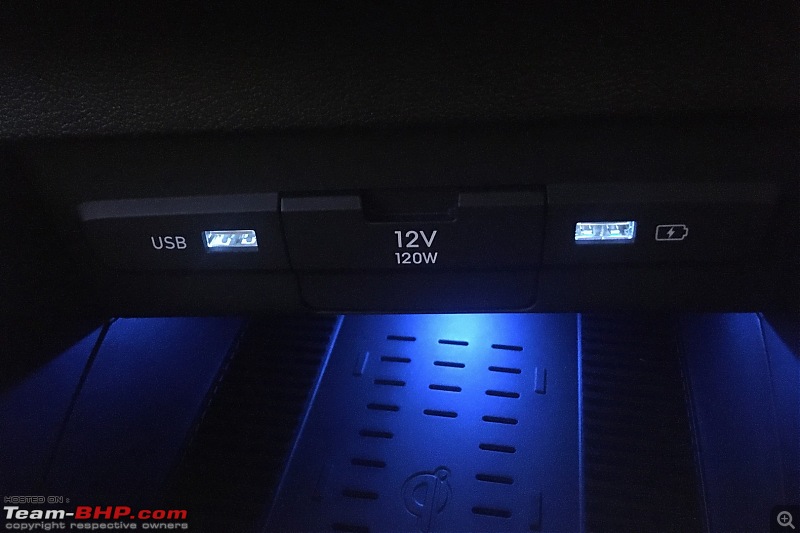 The ubiquitous Hyundai automatic gear lever. Do note that this turbo-petrol DCT variant doesn’t get paddle shifters, sadly. Manual shifts are through the gear lever only:  As is the norm with all Hyundai launches these days, the i20 also gets an air purifier:  The glovebox is cooled and quite accommodating:  Yet another crowd puller in this car is the 7-speaker BOSE sound system. It comprises of 4 door speakers, 2 tweeters (on the front doors) and a subwoofer in the boot along with…  …this amplifier placed under the front passenger seat. We appreciate how manufacturers are now focussing on the in-car entertainment experience too: 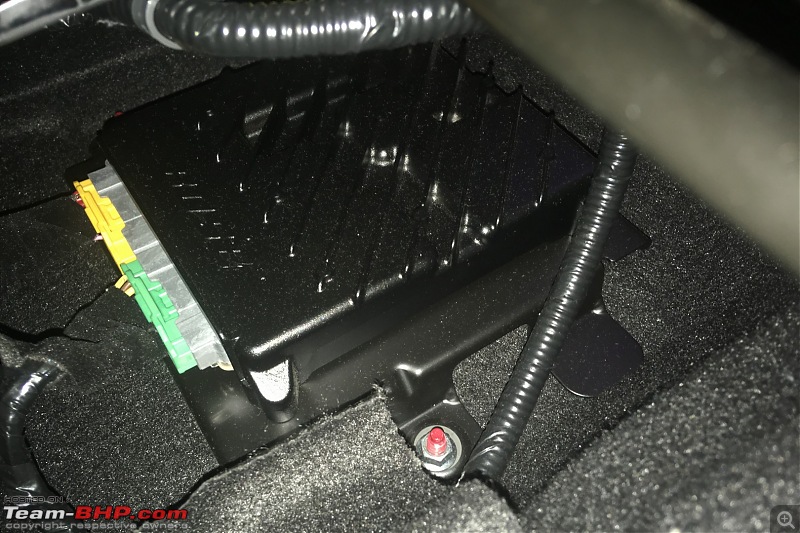 The previous-generation i20 had adequate room, but the Baleno had noticeably more space. The added cabin width and wheelbase have surely helped make the new i20's backseat more spacious than before: 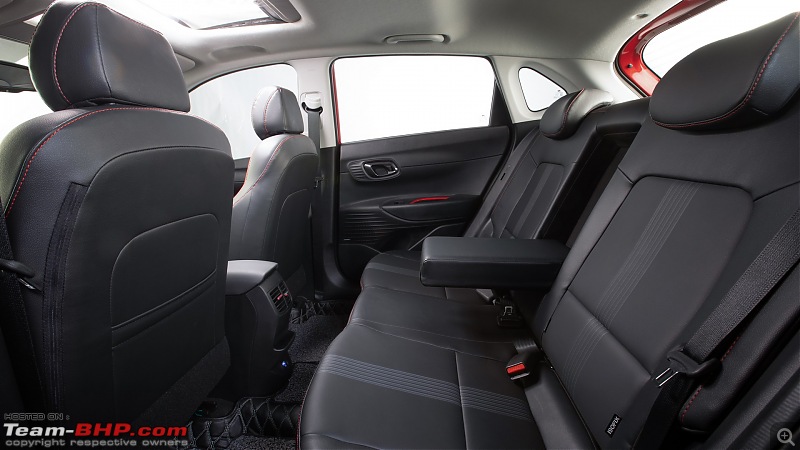 Here is a picture of me, with the driver seat adjusted to my position (I'm 5’ 10” tall). I had approximately 3.5-4 inches of knee room to spare! 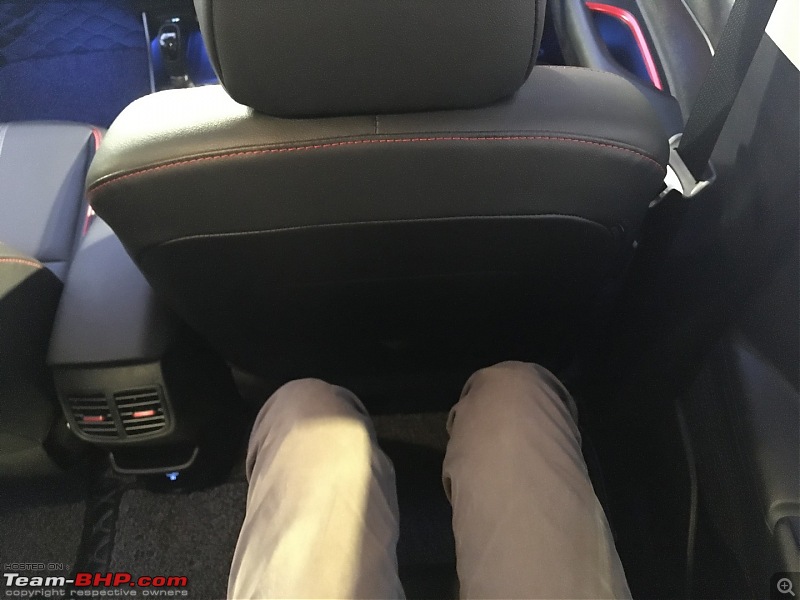 Has an armrest, but weirdly, no cupholders (the Elite i20 had cupholders here):  Rear AC vents get red accents: 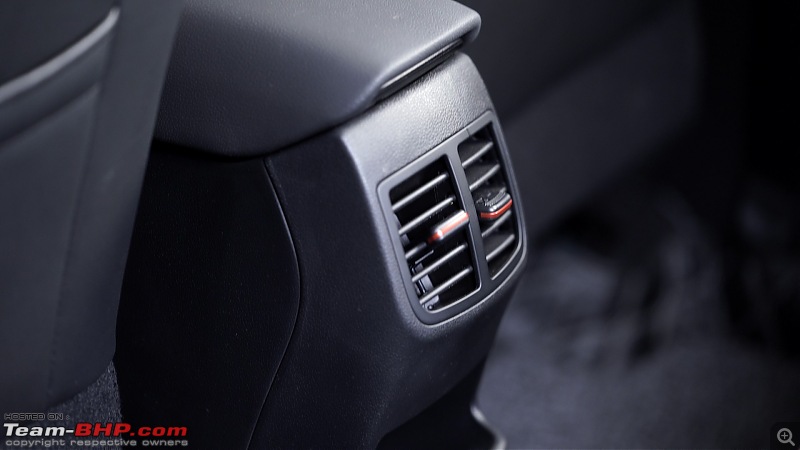 Below, you have USB charging and a slot to park your mobile phone:  Boot space has gone up to 311 litres (26L more than before). It’s still not as accommodating as the Maruti Baleno (339 litres), Tata Altroz (345 litres) & Honda Jazz (354 litres):  Last edited by Aditya : 9th November 2020 at 17:27. |
| |  (69)
Thanks (69)
Thanks
 |
| The following 69 BHPians Thank Omkar for this useful post: | Abhinav V, ach1lles, akash_v12, akshay81, anumod, Arnav Vaghela, ashvek3141, AVIS, CARDEEP, CEF_Beasts, chiefpk, Chrome6Boy, Crazy_cars_guy, dailydriver, Dani7766, Dexter_, digitalnirvana, DriverNo.420, Durango Dude, espraveen, Gaboonviper04, gearedup, govigov, govindremesh, GTO, guyfrmblr, hemanth.anand, KarthikK, landcruiser123, lovetorque, MDED, MSAneesh, Mynameis, N33raj, Night_Fury, Ponbaarathi, Potenza, PraNeel, RaghuVis, Rambo-RS, RavenAvi, RBalaM, rbp1988, RBR, Redline6800, Reinhard, Researcher, RSR, S.MJet, saisailendra, SchumiFan, Simhi, Subby, SuhairZain, swiftnfurious, The Rationalist, theexperthand, The_Outsider!, Tormoz, TorqueTwist, Utham123, V.Narayan, vaasu, vb-saan, Viju, Vik0728, vredesbyrd, YashD, yogiii |
| | #3 |
| Team-BHP Support  | Over the years, the Hyundai i20 has been one of the best selling cars in the B2 hatchback segment. On many occasions, it has sold well over 10,000 units a month! Quality, features and overall 'premium'ness have been strong points of the car. Needless to say this new i20 has big shoes to fill. I spent a day with the 2020 Hyundai i20. My quick & brief observations below:  Overall, Hyundai have done a good job with the new i20. There is a range of engines and gearboxes to choose from. The star performer is the 1.0L turbo-petrol from the Venue, which makes the i20 quite a hot hatch. The ride is compliant and the handling is neutral. Besides, the car is loaded with features such as sunroof, Bose 7-speaker sound system, Blue Link telematics with 50 connected car features and over-the-air map updates, hill assist control, 6 airbags, fully digital instrument cluster with TPMS, rear air-con vents, wireless charging with cooling pad, air purifier, tilt & telescopic steering, ambient lighting and more. There’s a 5-year Wonder Warranty available as well. On the downside, many BHPians have found the higher variants to be overpriced - no doubt, this is an expensive hatchback with the top AT costing 13 lakhs OTR Mumbai (more in Bangalore). While the interior space and quality are good, the rear seat is placed low and its under-thigh support is compromised. Features such as an auto-dimming IRVM, auto wipers and split folding rear seats are missing. Another complaint we have is that the 195/55 section tyres run out of grip easily. An upgrade to better quality rubber is highly recommended. Exterior The car looks good from the front. It’s neutral and unlikely to offend anyone. The rear end is exactly the opposite with weirdly shaped tail-lamps and a chrome strip running between the 2 light clusters - the derrière will divide opinions for sure. By and large, the car feels well put together. The bonnet, hatch & doors have some weight to them. The paint quality is top notch and fit & finish are best in the segment. Shut lines are nice and consistent - as expected from Hyundai. The new i20 draws a lot of attention from other road users. Since the i20 has been a popular car, people want to know more about the new model. Brand loyalty is strong here. Front end is dominated by a large, glossy black grille with a Turbo badge. DRLs are placed on top of the headlamp clusters and give the car good street presence:  Rear end is a love it, hate it affair. I'm not fond of the chrome strip running between the two tail-lamp clusters; GTO on the other hand likes the design:  Overhangs are short. Chrome bits are overdone: 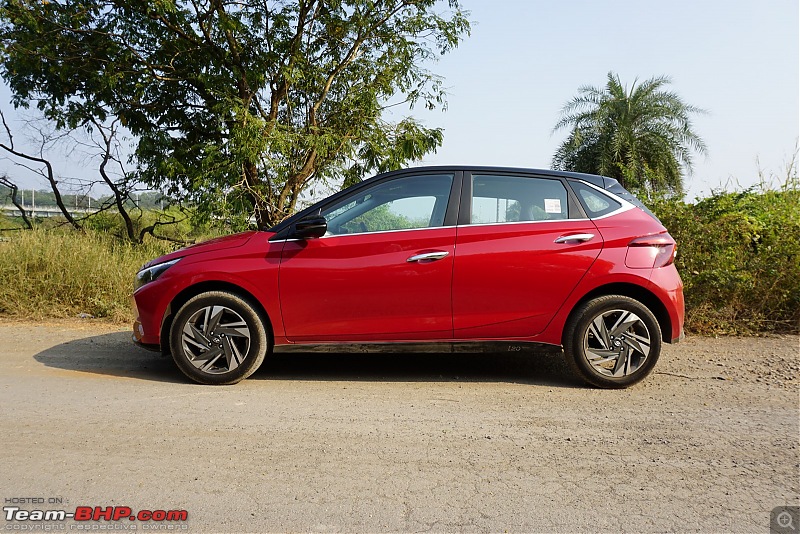 Sunroof appears small, but lets adequate light into the cabin: 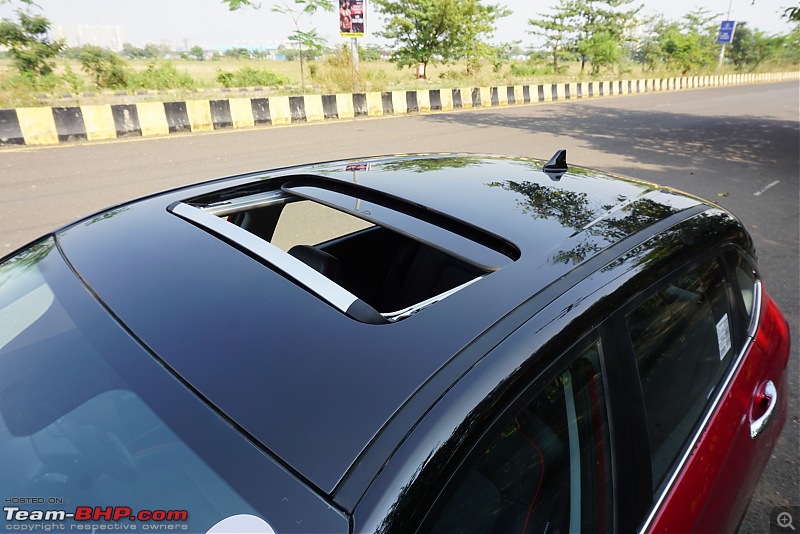 Exhaust pipe is neatly concealed by the rear diffuser:  Interior On the inside, there are no soft touch materials used anywhere. It's all hard plastic, yet everything seems to be of good quality. The black dashboard with red inserts (in dual-tone body colours) looks very sporty. The sunroof prevents things from getting too dark. Space is good and the ergonomics are spot-on. I was at home in a matter of seconds of entering the cabin. The driver's seat offers enough support and with the sliding armrest, one can get comfortable in quick time. At the rear, there is more space than before. The problem is that the seat is placed very low. You have to sit down in this seat. Under-thigh support is compromised. As with most new cars, the i20's head-unit is now tablet-like. It's a 10.25-inch HD unit with Blue Link telematics, Apple CarPlay, Android Auto and a Bose 7-speaker sound system. Sound quality is good for a stock system. The climate control is very effective and chills the interior in seconds even on a hot day. The rear air-vents help matters further. Black dashboard with red inserts. There are no soft-touch plastics here, but the quality is right up there with the best in the segment. Everything is well put together and feels built to last: 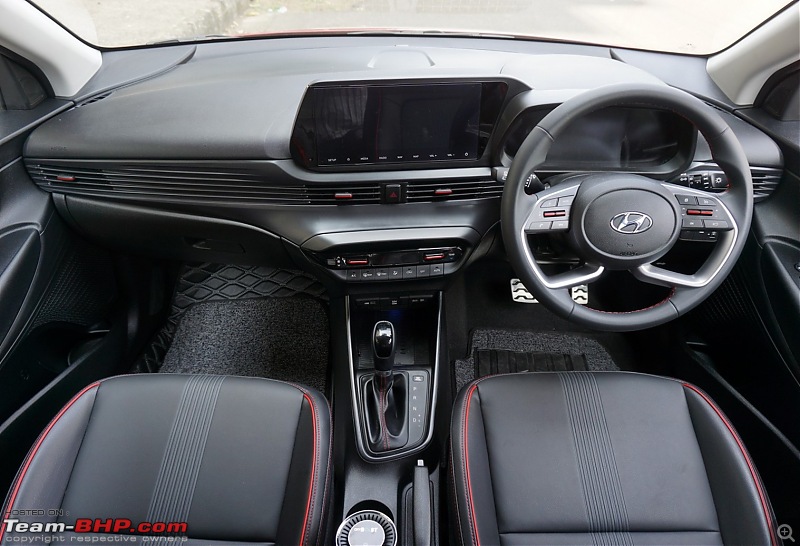 Steering has rake and reach adjustment, which helps in getting the perfect driving position! Hyundai has dropped this from more expensive models, and I'm glad to see the i20 offering telescopic adjustment:  Fully digital instrument cluster. We don't like this and prefer analogue dials, or the UK-spec i20's more premium display:  TPMS and door ajar warnings for all doors, including the bonnet and sunroof (if engine is switched off). Sadly, a temperature gauge for the DCT is not provided:  Sporty pedals in the turbo-petrol:  All-black doorpads get a red insert and ambient lighting:  Smart-looking black & red leather seats are quite comfortable and provide good overall support: 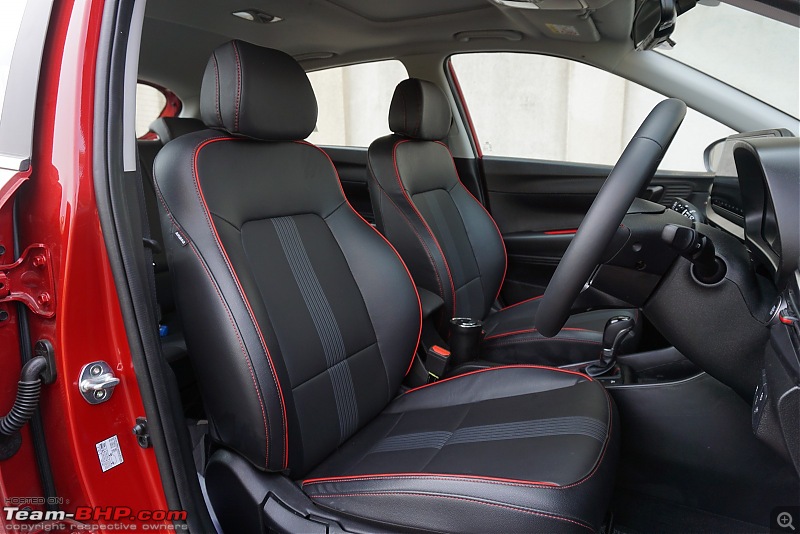 Sliding armrest is handy:  ORVMs are wide:  IRVM covers the entire rear windshield. Sadly, it does not get auto-dimming:  Massive 10.25-inch touchscreen. It stands out above the dashboard, alongside the instrument cluster. It has a crisp display with quick guide buttons at the bottom. Another benefit of having a wide screen like this is that you can enjoy a split display:  2 backlit USB ports and a 12V charging socket. The space below the slots is occupied by a cooled wireless charging pad which also gets an ambient light:  As is the norm with all Hyundai-Kia launches these days, the i20 also gets an air purifier: 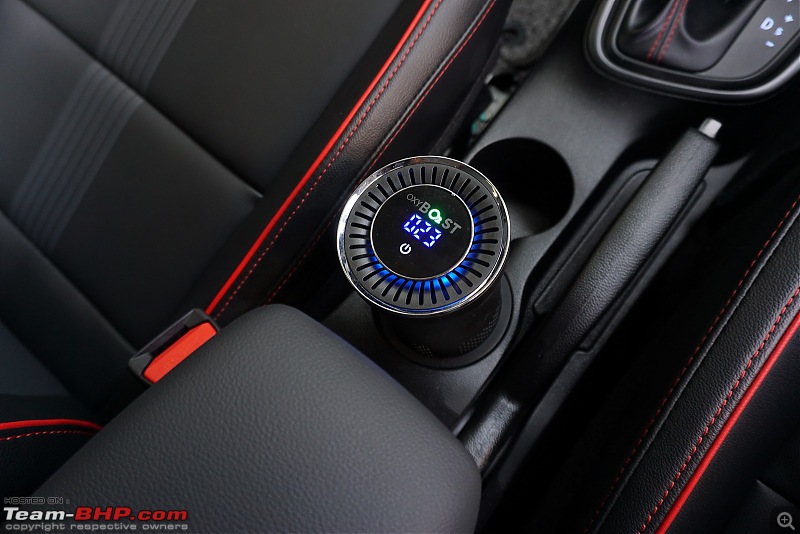 The size of the sunroof is just adequate for the cabin:  Rear seat is more spacious than before, but it is low and under-thigh support is poor. Seat back is not split: 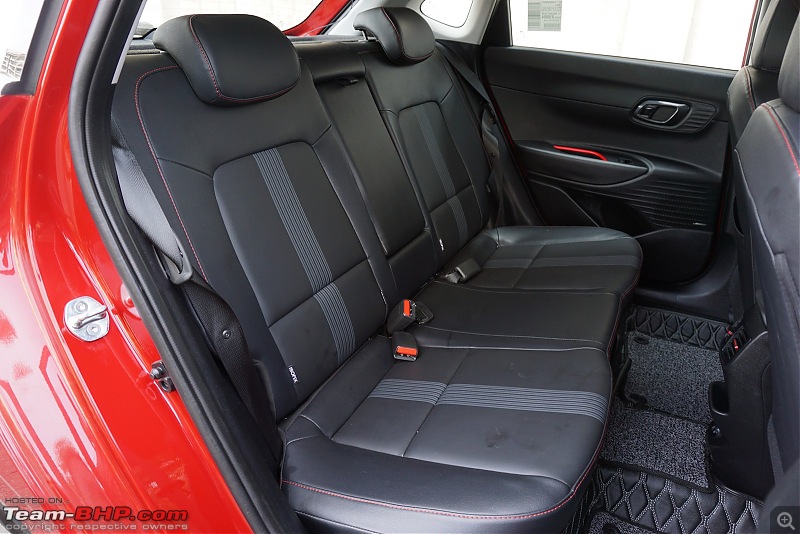 Rear air-con vents with a USB port below:  311 liters of boot space. It can be increased by folding the seatback forward. Subwoofer is located on the left, while a boot light and bag hook are on the right. 4 tie-down hooks are provided in the corners:  Spare is a 15-inch steel unit with a 185/65 tyre:  Driving the 1.0L Petrol AT The i20 petrol is powered by Hyundai’s in-house developed 998cc, 3-cylinder turbocharged engine. It's called the Kappa 1.0 Turbo GDI, and gets a direct injection fueling system, electronic wastegate actuator, a variable oil pump, oil spray jets for the pistons from the crank side and dual variable valve timing. This is the same engine that is used in the Venue. The 1.0L petrol produces a strong 118 BHP (@ 6,000 rpm) and 172 Nm (1,500 - 4,000 rpm). That power figure puts it ahead of its direct rivals, but the Polo 1.0L TSI matches it on torque. Hyundai is offering a 7-speed DCT as an option with the i20 1.0L petrol. The company has always been big on automatic gearboxes in India (right from the original Santro). The DCT is available only in the Asta and Asta (O) trim levels. Both are equipped with hill-start assist and electronic stability control. The i20 AT is the only car in the segment with a DCT. 7 ratios also result in a superior spread of gearing and this transmission does feel decidedly superior to its rivals, but sadly, there are no paddle shifters. The DCT gearbox is smooth and the entire package is very refined. On the flip side, it is substantially more expensive than its rivals. The i20 DCT is very refined at idle. It moves off seamlessly from a standstill. There is a slight initial lag though, as there is no torque-converter & due to the turbo-charger. Once you're moving, light accelerator input is all you'll need to commute in the city. The gearbox moves up early, while shifts are quick and smooth. Driving with a light foot, you'll never even know that the gears are being changed. They are almost imperceptible. The turbo-petrol offers enjoyable acceleration, while the power & torque on tap make the gearbox's job easier. We also liked how the gearbox is never found hunting for gears. Combine this smooth AT with the light steering, excellent ergonomics & clean frontal visibility and you have a sweet city ride. For bumper to bumper traffic conditions, there is a fair amount of 'crawl' available too. Just lift your foot off the brake pedal in 'D' and the i20 will crawl forward, allowing you to drive in bad traffic with just one pedal (the brake). Downside? The i20 DCT is reluctant to downshift from 2nd -> 1st. Hence, you'll need to be patient if you want to suddenly close a gap in slow traffic (as an example). Thanks to the powerful engine, the i20 DCT is a fast expressway cruiser. You can easily hit silly speeds and the mid-range is punchy. It sure comes in handy for overtaking. For long distance cruisers, the engine spins @ 2,600 rpm at 120 km/h (100 km/h = ~2,100 rpm). Kickdown response time is average. If the revvs are low, it takes a second or so for the gearbox + turbo to react. Sometimes, you'll find the gearbox to be hesitant to downshift too. But once the AT & turbo respond, this thing is very peppy. Will add that, when the engine is in the meat of the powerband, the reaction times are far lesser. The 7-speed DCT shifts faster than most of the gearboxes used by its rivals. Just wish Hyundai had given it paddle shifters. Manual mode is useful when you want to prepare the car for overtaking a fast vehicle on a 2-lane highway, or when you desire engine braking. Move the gear lever to the right to engage manual mode. The response time to your commands is quick. What we found disappointing was that, even here, you can take the revvs to just ~6,500 rpm (which is the start of the redline) before the transmission shifts up on its own. What is impressive is that, you can downshift even with the revvs at 3,800 rpm, which is more than most other ATs allow you to do. We'll keep our fingers crossed on the long-term durability of this gearbox. While it's reassuring to have a manufacturer with a track record for reliability backing it, the fact is that no dual-clutch gearbox has had a clean reputation in India. Not Ford's DCT, and certainly not VW's notorious DSG. We'll be keeping a keen eye on reports from i20 owners. Be sure to take that extended warranty package! Coming to NVH levels, the i20 does very well at slow speeds and around town. On revving, you can hear that familiar 3-cylinder thrum though. While this noise is there, it is not excessive. There’s almost no engine sound heard in the cabin if you're driving in a calm manner. Even while cruising on the highway, the engine is silent enough. What we appreciated is that the motor actually sounds nice when revved hard. Enthusiasts will like. Around 3,500 rpm, the engine gets audible, and is l-o-u-d above 6,000 rpm. Wind noise is minimal at 100 km/h, while road and tyre noise are par for the course. In terms of fuel economy, the i20 turbo-petrol DCT carries an ARAI rating of 20.25 km/l. 998cc turbo-petrol engine develops 118 BHP & 172 Nm:  The ubiquitous Hyundai automatic gear lever. Do note that this turbo-petrol DCT variant doesn’t get paddle shifters, sadly! There is a manual / sport mode though. To engage it, move the lever to the right. Push the lever up to upshift and down to downshift (just the way we prefer it):  Ride & Handling The i20 uses a McPherson strut suspension with coil springs at the front and a coupled torsion beam at the rear. The suspension tune is sorted & owners will be satisfied. Low speed ride quality is compliant & mature, with small bumps being absorbed well. While the suspension feels firmer than the old i20, it is not excessively so. Only the bigger potholes make their presence felt inside. The car feels quite comfortable on the expressway as well. While our test car was equipped with 16" wheels, lesser variants get 15" rims with taller rubber which will be cushier. Out on the open road, straight line stability is excellent, while the handling is neutral & predictable. It's no VW or Ford, yet the behaviour is sorted. The i20 remains composed through fast corners too. There is some body roll, but it's controlled. The dynamics are clean with no nasty surprises at all, although again, it doesn't dismiss mid-corner bumps like a Polo does. Important to note that the Asta (O) and DCT variants are equipped with electronic stability control (ESC) which can be a lifesaver in emergency situations. The grip provided by the 195/55 Ceat Secura Drive tyres is acceptable for regular drivers. Enthusiasts with a hard driving style will want to upgrade to stickier rubber. The electric power steering is light and butter-smooth at parking / city speeds. Along with its small size, this makes for a very easy car to drive in urban conditions. On the highway, the steering is not nervous. Those days of crazy Hyundai steerings are gone. The steering weighs up alright at speed and it's not overtly sensitive either. No owner will complain. The car's behaviour is overall neutral in nature, as one would expect a mass market hatchback to be. All variants of the i20 come with disc brakes at the front and drums at the rear, with ABS + EBD. The brakes perform as expected. The car stops in a straight line sans drama when braking from high speeds. McPherson strut suspension with coil springs at the front:  Rear suspension is a coupled torsion beam setup: 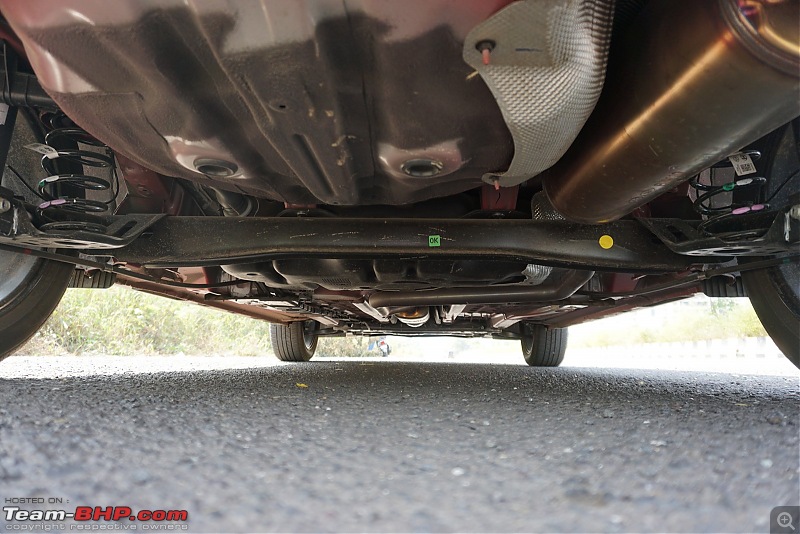 Last edited by Aditya : 12th November 2020 at 11:15. |
| |  (26)
Thanks (26)
Thanks
 |
| The following 26 BHPians Thank Aditya for this useful post: | akshay81, black_and_red, Chrome6Boy, dailydriver, dhruvritzed, digitalnirvana, DriverNo.420, Durango Dude, Gaboonviper04, GTO, g_sanjib, N33raj, Omkar, Potenza, Rambo-RS, RBR, Researcher, revsperminute, Rigid Rotor, RSR, Rudra Sen, supertinu, swiftnfurious, The Rationalist, Tormoz, vredesbyrd |
| | #4 |
| Distinguished - BHPian  Join Date: Jun 2020 Location: Mumbai
Posts: 2,743
Thanked: 18,120 Times
| re: Hyundai i20 Review Excellent detailed preview  Only grouse I have is the price of the DCT variants, otherwise usual Hyundai way of loading the car with features to the brim. Though the 120bhp motor will be a hoot to drive, wish it had a manual transmission! Giving an iMT instead of a manual in a turbo version makes no sense. Now lets see what Tata gives with the Altroz Turbo petrol, hope to see a manual and better pricing! Last edited by CEF_Beasts : 5th November 2020 at 13:12. |
| |  (6)
Thanks (6)
Thanks
 |
| The following 6 BHPians Thank CEF_Beasts for this useful post: | batladanny, espraveen, GTO, Napalm, Nonstop-driver, The Rationalist |
| | #5 |
| BHPian Join Date: May 2020 Location: New Delhi
Posts: 399
Thanked: 1,039 Times
| re: Hyundai i20 Review I agree the pricing is not justified and atrocious. But if we talk about the top-end variant then the Venue comes in the SX+ trim and not SX(O) trim in the DCT priced at 11.48 and 11.65 lacs respectively and is still priced higher than the i20 Asta(O) turbo DCT priced at 11.18 lacs. But the actual comparison should be with the Sonet GTX+ which is priced at 12.89 lacs so the difference of around 1.7 lacs is justified I suppose. Last edited by sv97 : 5th November 2020 at 13:34. |
| |  (7)
Thanks (7)
Thanks
 |
| The following 7 BHPians Thank sv97 for this useful post: | espraveen, GTO, jeganatu, jithin23, klgiridhar, Napalm, The Rationalist |
| | #6 |
| Team-BHP Support  | re: Hyundai i20 Review Hyundai claims 10 First-in-Segment features on the all-new i20 –
And a few claimed Best-in-Segment features -
But, personally I see some issues with the package - 1. Pricing is on the higher side, about 50k - 1L more than I expected. 2. At this price - diesel should have been given the full spec tune. Hyundai went for the highest mileage tag instead. There is no diesel + TC option as well - which Kia offers in the Sonet. 3. A 120ps tune of the 1.0 TGDi should have been rewarded with a proper manual gearbox - at least in one of the trims. During the presentation - it was claimed to have a 9.9 second run to 100kmph - would have been a good option with a manual gearbox. Last edited by CrAzY dRiVeR : 5th November 2020 at 13:17. |
| |  (28)
Thanks (28)
Thanks
 |
| The following 28 BHPians Thank CrAzY dRiVeR for this useful post: | akshye, arun1100, AYP, CEF_Beasts, espraveen, GTO, jeganatu, jithin23, Madywheel, PrasunBannerjee, RavenAvi, ravib, Redline6800, Researcher, Roy.S, Seenz, shibujp, sid__kaps, Simhi, SuhairZain, swiftnfurious, The Rationalist, theAutomaniac, theexperthand, vb-saan, Viju, Waspune, YashD |
| | #7 |
| BHPian Join Date: Jul 2020 Location: Ambala, Haryana
Posts: 363
Thanked: 2,624 Times
| re: Hyundai i20 Review Looks decent, but isn't it a little too overpriced?? I mean, the 6.8 lakh pricing is still introductory till 31st December!(Expect a price hike of atleast 20K!) When we consider the leaked prices of the upcoming Altroz turbo, the turbo petrol motor is said to start from 6.99 Lakh INR in the XT trim, which is a much more sensible car for the price, considering the i20 1.2 Magna is just Rs. 20,000 cheaper, that too with a lethargic engine! Yes, the top trims might be sensible, but lower trims do not make sense atleast to me! Last edited by theAutomaniac : 5th November 2020 at 13:17. |
| |  (17)
Thanks (17)
Thanks
 |
| The following 17 BHPians Thank theAutomaniac for this useful post: | aravind.anand, batladanny, Car Architect, GTO, jeganatu, kevindsouza113, klgiridhar, Napalm, Night_Fury, RavenAvi, SatishBisht, Seenz, sri_tesla, swiftnfurious, The Rationalist, Viju, yesyeswe |
| | #8 |
| BHPian Join Date: Dec 2018 Location: Noida
Posts: 549
Thanked: 1,198 Times
| re: Hyundai i20 Review Wasn't this price expected? The top-end Altroz XZ(O) Petrol is priced at INR 7.75 lacs and the new i20 has a lot more additional equipment: 4 additional airbags, sunroof, TPMS, larger infotainment, air purifier, wireless charging, LED headlamps (not sure), and Blue Link. All this kind-off justifies the bump in price over the Altroz. I know the pricing might appear insane but this was more or less expected, given the equipment list. |
| |  (3)
Thanks (3)
Thanks
 |
| The following 3 BHPians Thank tarik.arora for this useful post: | dark.knight, klgiridhar, Nithesh_M |
| | #9 |
| BHPian Join Date: May 2020 Location: New Delhi
Posts: 399
Thanked: 1,039 Times
| re: Hyundai i20 Review People after looking at the new i20's prices be like " Has Hyundai started including road tax and insurance in the ex-showroom price  " "Because other cars in the segment cost this much on-road.  All those who got the previous gen would be thanking their stars that they didn't wait for this as for a few features here and there they are charging a fortune. I think this is the first time I feel getting the previous gen car was a better option than this. |
| |  (27)
Thanks (27)
Thanks
 |
| The following 27 BHPians Thank sv97 for this useful post: | akash_v12, aravind.anand, arun1100, AutoConsultant, batish, batladanny, Car Architect, desiaztec, JS Kwt, kevindsouza113, klgiridhar, Mahesh Prasad, maverick.munish, Napalm, Night_Fury, Ponbaarathi, RavenAvi, rbp1988, sakthivelm, sri_tesla, swiftnfurious, sydras, The Rationalist, theAutomaniac, Turbohead, wbd8779, yesyeswe |
| | #10 |
| BHPian Join Date: Jan 2020 Location: Noida
Posts: 97
Thanked: 146 Times
| re: Hyundai i20 Review 11.17 price of top end DCT is not justified at all. Cutting too close to venue SX+. |
| |  (2)
Thanks (2)
Thanks
 |
| The following 2 BHPians Thank nisshith for this useful post: | Napalm, vredesbyrd |
| | #11 |
| BHPian Join Date: Apr 2020 Location: New Delhi
Posts: 220
Thanked: 615 Times
| re: Hyundai i20 Review Touching 13 Lacs OTR for the top end variant is seriously premium hot hatch pricing, and only those who really want a hot hatch will concede, and IMO that these buyers are far and few between, and will mostly end up picking the Sonet or Venue over a "Hatchback". |
| |  (1)
Thanks (1)
Thanks
 |
| The following BHPian Thanks armaan_singh for this useful post: | vredesbyrd |
| |
| | #12 |
| BHPian | Hyundai i20 1.2 (Sportz)- 7.60 ex-showroom Vs Tata Altroz 1.2 (Xz trim)- 7.60 ex-showroom Hyundai i20 Diesel (Sportz) - 9 lakhs ex-showroom vs Tata Altroz Diesel (XZ trim) - 8.79 ex-showroom That's just absurd pricing in my opinion. Altroz surely seems a better buy. |
| |  (14)
Thanks (14)
Thanks
 |
| The following 14 BHPians Thank ATRONIX for this useful post: | aravind.anand, Car Architect, extreme_torque, jeganatu, klgiridhar, Napalm, Night_Fury, RavenAvi, RedPhobos, rkv_2401, Seenz, The Rationalist, theAutomaniac, wbd8779 |
| | #13 |
| BHPian Join Date: Jul 2019 Location: Bangalore
Posts: 175
Thanked: 294 Times
| re: Hyundai i20 Review We were contemplating on booking a top end DCT turbo. The OTR of almost 13.5 in Bangalore is really on a higher side. We thought the top end would hit around 12L OTR. For comparison, another contender which was in our list was Honda City 5th Gen Base Variant. Which is around 13.8L. I know, its like comparing apples and oranges. But, we wanted to stick to a budget and then look for feature loaded cars around it. We will test drive it to see if it worth the asking price. |
| |  (6)
Thanks (6)
Thanks
 |
| The following 6 BHPians Thank shashi792 for this useful post: | Car Architect, jeganatu, RavenAvi, Redline6800, rohittunga, sri_tesla |
| | #14 |
| BHPian | re: Hyundai i20 Review Does the average Premium hatch customer even demand or expect this level of tech/equipment? Even if they want all these features, they would rather go for a Venue/Sonet/Nexon. Just look at the highest selling car in the segment - Baleno. Even after all the highlighted safety concerns, it was the 2nd highest selling car last month. Its base variant is priced at 5.6 and the highest selling Delta variant is 6.45 whereas i20 starts at 6.8 . If the i20 base variant was priced equal to Baleno Delta variant, customers would have been willing to sacrifice a few features for a fresher car with enhanced safety. |
| |  (6)
Thanks (6)
Thanks
 |
| The following 6 BHPians Thank AutoConsultant for this useful post: | Col Mehta, Napalm, RedPhobos, SatishBisht, theAutomaniac, yesyeswe |
| | #15 |
| BHPian Join Date: Dec 2019 Location: Bengaluru
Posts: 947
Thanked: 3,503 Times
| re: Hyundai i20 Review Summing up my feelings on waiting for the new i20 all this while, looking at the price premium and then running back to TATA Altroz. Come on TATA, this is golden opportunity to make some significant sales in the premium hatchback segment. |
| |  (75)
Thanks (75)
Thanks
 |
| The following 75 BHPians Thank JithinR for this useful post: | Abhinav V, apache_aayush, aravind.anand, arun1100, AutoConsultant, Babruvahanaaaaa, batladanny, Car Architect, chiefpk, Chrome6Boy, DeKay, dZired, fhdowntheline, Flash777, Godzilla, greyhound82, guyfrmblr, iliketurtles, ishan12, itsmb, jailbird_fynix, Jas21, jeganatu, jithin23, KINI, klgiridhar, K_Drive, Latheesh, Mahesh Prasad, museycal, myavu, nalinsaxena23, Napalm, Neeraj1903, Night_Fury, Pigcee, Ponbaarathi, PPS, PrasannaDhana, punto_, RaghuVis, rajvardhanraje, RavenAvi, rbp1988, RJ2285, S.MJet, Sachin V.W., SansGT, Scorpio80, Seenz, self_driven, Shanksta, shivanshbhatt, Shreyans_Jain, skarthiksr, sri_tesla, SS8939, ST172, SuhairZain, Teesh@BHP, The Rationalist, theAutomaniac, theexperthand, The_Outsider!, Torque_Curve, Turbohead, Ultim8, vaish9925, VinNam, vj1303, vj_torqueaddict, Vysakh, wbd8779, yesyeswe, zhopudey |
 |

